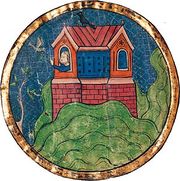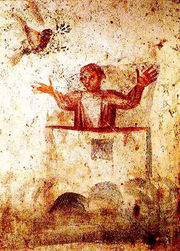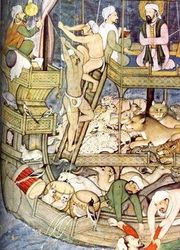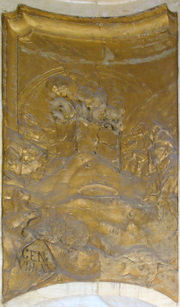Noah
Noah (or Noe, Noyach; Hebrew: נֹחַ, נוֹחַ, Modern Noaẖ Tiberian Nōăḥ; Arabic: نوح Nūḥ; Greek: Νωέ) was, according to the Hebrew Bible, the tenth and last of the antediluvian Patriarchs. The biblical story of Noah is contained in chapters 6–9 of the book of Genesis, where he saves his family and representatives of all animals from the flood by constructing an ark.[1] He is also mentioned as the "first husbandman" and in the story of the Curse of Ham. Noah is the subject of much elaboration in later Abrahamic traditions.
Contents |
Tradition
- The following section is a summary of the Book of Genesis, chapters 6–9.
Noah was the son of Lamech who named him Noah, saying, "This same shall comfort us in our work and in the toil of our hands, which cometh from the ground which the LORD hath cursed."[2] In his five hundredth year Noah had three sons, Shem, Ham, and Japheth. In his six hundredth year God, saddened at the wickedness of mankind, sent a great deluge to destroy all life, but instructed Noah, a man "righteous in his generation," to build an ark and save a remnant of life from the Flood.
After the Flood, "Noah was the first tiller of the soil. He planted a vineyard; and he drank of the wine." Noah's son Ham saw his father naked in his father's tent, and told his brothers, and so Noah cursed Ham's son Canaan, giving his land to Shem.[3]
Noah died 350 years after the Flood, at the age of 950,[4] the last of the immensely long-lived antediluvian Patriarchs. The maximum human lifespan, as depicted by the Bible, diminishes rapidly thereafter, from as much as 900 years to the 120 years of Moses.
Jewish perspectives

The righteousness of Noah is the subject of much discussion among the rabbis.[5] The description of Noah as "righteous in his generation" implied to some that his perfection was only relative: In his generation of wicked people, he could be considered righteous, but in the generation of a tzadik like Abraham, he would not be considered so righteous. They point out that Noah did not pray to God on behalf of those about to be destroyed, as Abraham prayed for the wicked of Sodom and Gomorrah. In fact, Noah is never seen to speak; he simply listens to God and acts on his orders. This led such commentators to offer the figure of Noah as "the man in a fur coat," who ensured his own comfort while ignoring his neighbour. Others, such as the medieval commentator Rashi, held on the contrary that the building of the Ark was stretched over 120 years, deliberately in order to give sinners time to repent. Rashi interprets his father's statement of the naming of Noah (in Hebrew נֹחַ) “This one will comfort (in Hebrew– yeNaHamainu יְנַחֲמֵנו) from our work and our hands sore from the land that the Lord had cursed”,[6] by saying Noah heralded a new era of prosperity, when there was easing (in Hebrew – nahah - נחה) from the curse from the time of Adam when the Earth produced thorns and thistles even where men sowed wheat and that Noah then introduced the plow.
Christian perspectives

The Gospel of Luke, (Luke17:26), equates Noah's Flood with the coming Day of Judgement: “Just as it was in the days of Noah, so too it will be in the days of the coming of the Son of Man.” Noah is called a "preacher of righteousness" in 2 Peter 2:5, and the First Epistle of Peter equates the saving power of baptism with the Ark saving those who were in it. In later Christian thought, the Ark came to be equated with the Church: salvation was to be found only within Christ and his Lordship, as in Noah's time it had been found only within the Ark. St Augustine of Hippo (354-430), demonstrated in The City of God that the dimensions of the Ark corresponded to the dimensions of the human body, which corresponds to the body of Christ; the equation of Ark and Church is still found in the Anglican rite of baptism, which asks God, "who of thy great mercy didst save Noah," to receive into the Church the infant about to be baptised.
Noah's three sons were generally interpreted in medieval Christianity as the founders of the populations of the three known continents, Japheth/Europe, Shem/Asia, and Ham/Africa, although a rarer variation held that they represented the three classes of medieval society - the priests (Shem), the warriors (Japheth), and the peasants (Ham). In the 18th and 19th centuries the view that Ham's sons in general had been literally "blackened" by the curse of Noah was cited as justification for black slavery.
Latter-day Saint perspectives
In Latter-day Saint theology, the archangel Gabriel lived in his mortal life as the patriarch Noah. Gabriel and Noah are regarded as the same individual; Noah being his mortal name and Gabriel being his heavenly name.[7]
Gnostic perspectives
Gnosticism was an important development of (and departure from) early Christianity, blending Jewish scriptures and Christian teachings with traditional pagan religion and esoteric Greek philosophical concepts. An important Gnostic text, the Apocryphon of John, reports that the chief archon caused the flood because he desired to destroy the world he had made, but the First Thought informed Noah of the chief archon's plans, and Noah informed the remainder of humanity. Unlike the account of Genesis, not only are Noah's family saved, but many others also heed Noah's call. There is no ark in this account; instead Noah and the others hide in a "luminous cloud".
Islamic perspectives

The Quran contains 43 references to Noah (نوح, Nūḥ) in 28 suras (chapters), notably Sura Nuh and Sura Hud. Sura 11 (Hud) is largely an account of the Flood. Sura 71 (i.e., Sura Nuh), of 28 verses, consists of a divine injunction to Noah to preach, a short sermon of Noah’s to his idolatrous contemporaries on the monotheism of Allah (God), and Noah’s complaint to God about the hardness of the people’s hearts when his preaching is met by ridicule.
Quran's Noah lives for a total of 1000 years,(consider difference in Solar and Lunar years) with the Flood coming in his 950th year; (In later tradition, only 83 people are willing to submit, i.e., become Muslim, "those who accept a peaceful yield to the god" with God; these 83 are saved with Noah). It is mankind's obduracy which eventually brings the wrath of God on the unbelievers.
The theme of the Quranic story is the unity of Allah and the need to seek peace with Him. The narrative does not include the Genesis account of Noah's drunkenness, and the possibility of the Curse of Ham narrative is in fact implicitly excluded: Qur'an doesn’t mention the number of Noah’s sons. Nevertheless the traditions of the Prophet Mohammed clearly mention that Noah had three sons,[8] and that all the population descended from them., and a fourth son who does not join his father despite Noah's final plea to be saved ("O my son! Come ride with us, and be not with the disbelievers!"); instead he flees to the mountains and drowns in the flood and God tells Noah that this is because he is an evildoer.[9] (In later Islamic tradition the son is given the name Kenan, "Canaan").
Shi'ah Muslims believe that Noah is buried next to Ali[10] within Imam Ali Mosque, in Najaf, Iraq.
Bahai perspective
The Bahá'í Faith regards the Ark and the Flood as symbolic.[11] In Bahá'í belief, only Noah's followers were spiritually alive, preserved in the ark of his teachings, as others were spiritually dead.[12][13] The Bahá'í scripture Kitáb-i-Íqán endorses the Islamic belief that Noah had a large number of companions, either 40 or 72, besides his family on the Ark, and that he taught for 950 (symbolic) years before the flood.[14]
Contemporary academic perspectives
According to the documentary hypothesis, the first five books of the Bible ( Pentateuch / Torah ), including Genesis, were collated during the 5th century BC from four main sources, which themselves date from no earlier than the 10th century BC. Two of these, the Jahwist, composed in the 10th century BC, and the Priestly source, from the late 7th century BC, make up the chapters of Genesis which concern Noah. The attempt by the 5th century editor to accommodate two independent and sometimes conflicting sources accounts for the confusion over such matters as how many pairs of animals Noah took, and how long the flood lasted.
More broadly, Genesis seems to contain two accounts concerning Noah, the first making him the hero of the Flood, the second representing him as a husbandman who planted a vineyard. This has led some scholars to believe that Noah was believed by the ancients to be the inventor of wine, in keeping with the statement at Genesis 5:29 that Lamech "called his name Noah, saying, 'Out of the ground which the Lord has cursed this one shall bring us relief from our work and from the toil of our hands.'"[15]

Noah's great grandfather Enoch is the beginning of a web of similarities between the story of Noah and older Mesopotamian myths. According to Genesis 5:24, at the end of his 365 years Enoch "walked with God, and was not, for God took him" - the only of the ten pre-Flood Patriarchs not reported to have died. It is not explicitly stated where he is taken in Genesis. However, in Hebrews 11:5, it states that he did not die. Enoch and Elijah in 2Kings 2:1, are two people who experienced assumption (did not see death). In a late Apocryphal tradition, Methuselah is reported to have visited Enoch at the end of the Earth, where he dwelt with the angels, immortal. The details bring to mind Utnapishtim, a figure from the Mesopotamian Epic of Gilgamesh - the hero Gilgamesh, after long and arduous travel, finds Utnapishtim living in the paradise of Dilmun / Bahrain at the end of the Earth, where he has been granted eternal life by the gods. (Gilgamesh's reason for seeking out Utnapishtim, incidentally, is to learn the secret of immortality - like Methuselah, he comes close to the gift but fails to achieve it). Utnapishtim then tells how he survived a great flood, and how he was afterwards granted immortality by the gods. It has been suggested that the Flood story may originally have belonged to Enoch.[15]
Lamech's statement that Noah will be named "rest" because "out of the ground which the Lord has cursed this one shall bring us relief from our work and from the toil of our hands," has another faint parallel in Babylonian mythology: the gods grew tired of working, digging the channels of the rivers, and so the god Enki created man from clay and blood and spit to do the work for them. Enki fell in love with his creation, and later warned Utnapishtim that the other gods planned to send a flood to destroy all life, and advised him on how to construct his ark.
Noah is also often compared to Deucalion, the son of Prometheus and Pronoia in Greek mythology. Like Noah, Deucalion is a wine maker or wine seller; he is forewarned of the flood (this time by Zeus); he builds an ark and staffs it with creatures - and when he completes his voyage, gives thanks and takes advice from the gods on how to repopulate the Earth. Deucalion also sends a pigeon to find out about the situation of the world and the bird return with an olive branch. This and some other examples of apparent comparison between Greek myths and the "key characters" in the Old Testament/Torah have led recent Biblical scholars to suggest a Hellenistic influence in the composition of the earlier portions of the Hebrew Bible.
See also
- Flood myth
- Gilgamesh flood myth
- Nagual
- Noahide Laws
- Nüwa
- Patriarchal Age
- Sons of Noah
References
- ↑ Noah's Ark - Jewish Encyclopedia
- ↑ Genesis 5:29
- ↑ Genesis 9:20-27
- ↑ Genesis 9:28-29
- ↑ "JewishEncyclopedia.com - Noah". http://jewishencyclopedia.com/view.jsp?artid=318&letter=N&search=Noah#982.
- ↑ Genesis 5:28
- ↑ "Encyclopedia of Mormonism - NOAH". http://eom.byu.edu/index.php/Noah.
- ↑ Tirmidhi, Ibn Abi Hatim, and ibn Jarir
- ↑ This section is based on Mark Hillmer, "The Book of Genesis in the Qur’an", Word & World 14/2 (1994)
- ↑ al-Qummi, Ja'far ibn Qūlawayh (2008). Kāmil al-Ziyārāt. trans. Sayyid Mohsen al-Husaini al-Mīlāni. Shiabooks.ca Press. pp. 66–67.
- ↑ From a letter written on behalf of Shoghi Effendi, October 28, 1949: Bahá'í News, No. 228, February 1950, p. 4. Republished in Compilation 1983, p. 508
- ↑ Poirier, Brent. "The Kitab-i-Iqan: The key to unsealing the mysteries of the Holy Bible". http://bahai-library.com/poirier_iqan_unsealing_bible. Retrieved 2007-06-25.
- ↑ Shoghi Effendi 1971, p. 104
- ↑ From a letter written on behalf of Shoghi Effendi to an individual believer, November 25, 1950. Published in Compilation 1983, p. 494
- ↑ 15.0 15.1 "NOAH". JewishEncyclopedia.com. http://www.jewishencyclopedia.com/view.jsp?artid=318&letter=N&search=noah#2. Retrieved 2010-03-15.
Further reading
- Michael E. Stone, Aryeh Amihay, and Vered Hillel, eds. Noah and His Book(s) (Society of Biblical Literature; 2010) 380 pages. Scholarly essays on debate over the existence of a lost "book of Noah," a text referred to in other texts.
- Bailey, Lloyd R. (1989). Noah, the Person and the Story. South Carolina: University of South Carolina Press. ISBN 0-87249-637-6.
- Young, Davis A. (1995). The Biblical Flood: A Case Study of the Church's Response to Extrabiblical Evidence. Grand Rapids, MI: Wm. B. Eerdmans Publishing. ISBN 0-85364-678-3.
- Ryan, William (1998). Noah's Flood. New York, NY: Simon & Schuster. ISBN 0-684-81052-2. http://books.google.com/?id=nPiuWaZgI60C&printsec=frontcover&dq=noah%27s+flood.
External links
- Jewish Encyclopedia: Noah from the 1901-1906 Jewish Encyclopedia
- Catholic Encyclopedia: Noah
- MuslimWiki: Nuh
|
|||||||||||||||||||||||||||||
|
||||||||||||||
|
||||||||||||||||||||